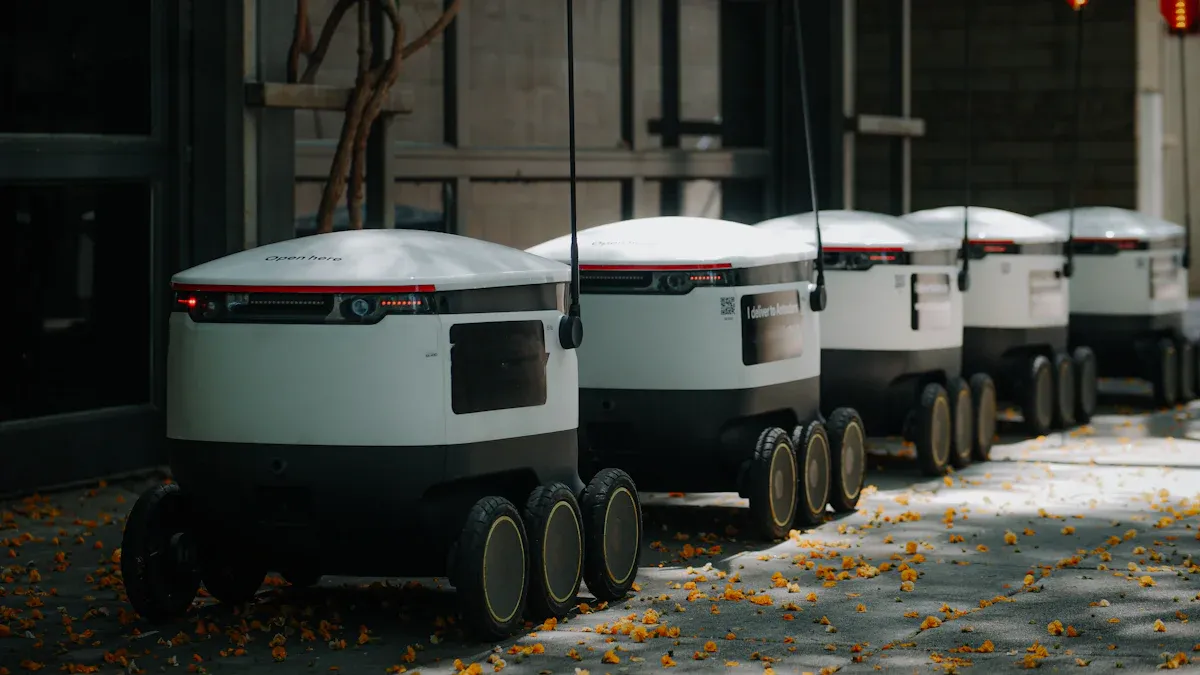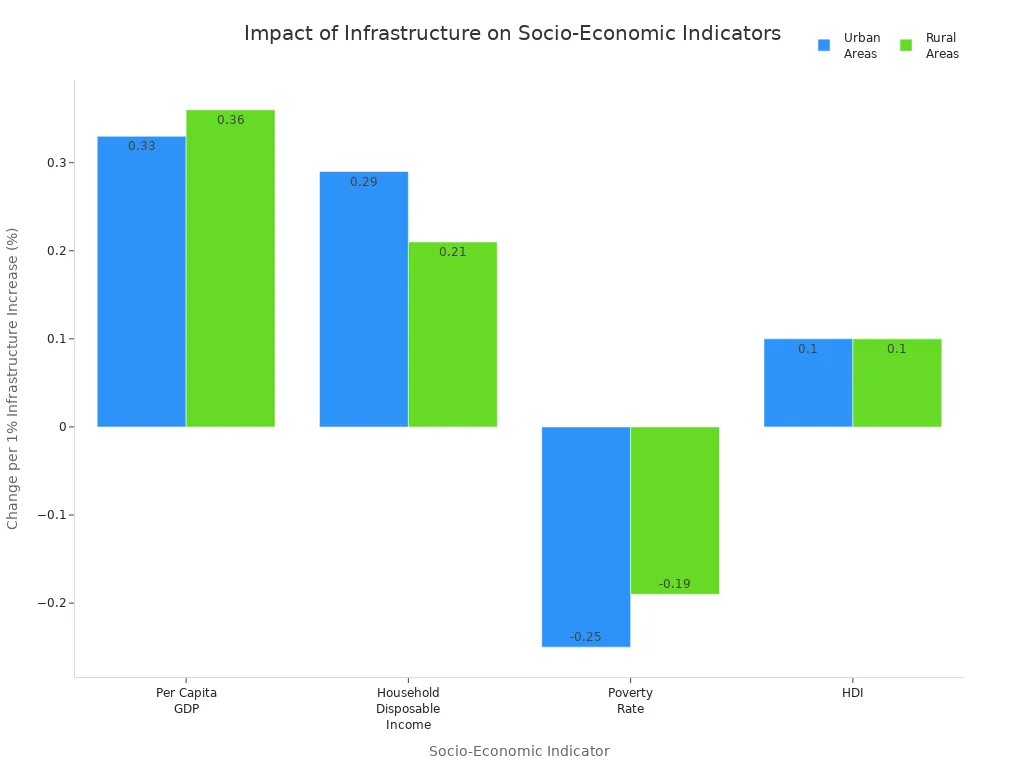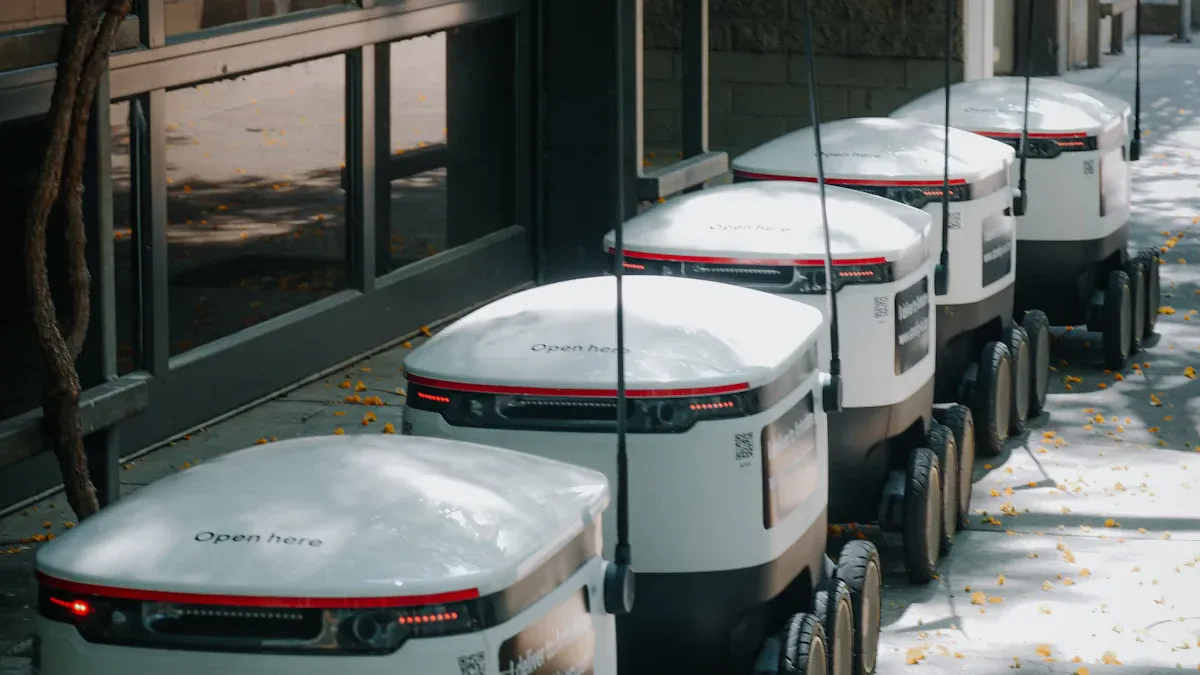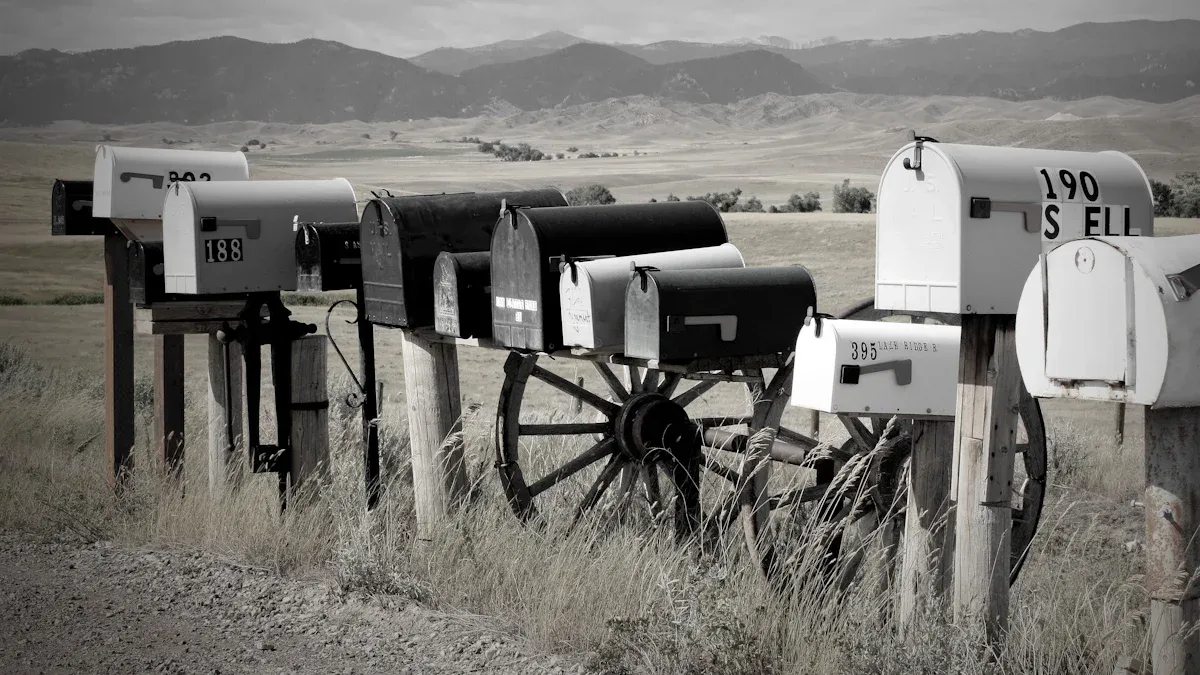Delivery Trends in Urban and Rural Areas in the United States

Delivery Trends in the United States show clear differences between urban and rural communities. Delivery services now play a vital role in daily life, helping people shop, eat, and stay connected.On-time package delivery rates remain similar across both areas, but urban regions enjoy broader access and faster adoption of new services.
Key Takeaways
Urban areas have higher delivery demand with faster service and more technology use, while rural areas face longer distances and fewer delivery options.
Strong infrastructure in cities supports quick deliveries, but rural regions need more investment to improve roads, internet, and access to services.
Delivery companies use new technology like drones, electric vehicles, and AI to solve challenges and make deliveries faster and greener in both areas.
Rural communities create local solutions like telehealth and community drivers to improve delivery and healthcare access.
Future delivery will focus on eco-friendly methods, contactless service, and expanding to more remote areas with smart policies and partnerships.
Delivery Trends Overview
Urban Patterns
Urban areas in the United States experience high package delivery volumes. Delivery drivers in cities often deliver between 200 and 350 packages each day. This number is much higher than in suburban or rural areas.
Route Type | Typical Packages Delivered per Day |
|---|---|
Urban | 200–350 |
Suburban | 150–250 |
Rural | 90–140 |
E-commerce growth drives these high numbers. Many people in cities order goods online, especially during peak seasons like the holidays. Delivery companies such as UPS have responded by building multistory warehouses in cities. These buildings help reduce delivery times and manage congestion. Companies also use electric-assist cargo bicycles and are testing autonomous vehicles to solve last-mile delivery problems.
Urban delivery trends show rapid growth and innovation. Companies focus on speed, convenience, and new technology to serve city dwellers.
Urban consumers report higher satisfaction with delivery services. Good roads, strong internet, and many delivery options make it easier for companies to meet customer needs.
Rural Patterns
Rural areas show different delivery trends. Drivers in these regions deliver fewer packages each day, usually between 90 and 140. Long distances and fewer customers per route make rural delivery more challenging.
Rural delivery patterns include:
Delivery times often stay under 45 minutes, but choices are limited.
Lower usage among older adults and children.
Delivery services cluster around small towns or groups of customers.
Some rural areas are testing new solutions. For example, 5G-connected drones help deliver food quickly and efficiently in places with poor roads. These innovations could improve access and reduce delivery times.
Rural customers face more challenges with delivery services. Poor roads, weak internet, and language barriers can lower satisfaction. Financial constraints also limit how often people use these services.
Studies show that rural consumers who use delivery apps often have strong motivation and positive attitudes toward new technology. They value the benefits and are willing to try new services when available.
Key Differences
Infrastructure
Infrastructure shapes how delivery services work in each area. Urban regions have better roads, strong internet, and more access to water, sanitation, and electricity. These features help delivery companies move quickly and safely. Rural areas often have weaker infrastructure. Roads may be rough or unpaved. Internet connections can be slow or unreliable. These challenges make it harder for delivery drivers to reach every home.
Aspect | Urban Areas | Rural Areas |
|---|---|---|
Number of Municipalities | 53 urban out of 234 total | Remaining classified as rural |
Access to Water, Sanitation, Electricity | Higher access rates, sometimes exceeding upper middle-income country averages | Lower access rates compared to urban areas |
Effect of 1% Increase in Basic Infrastructure on Per Capita GDP | +0.33% increase | +0.36% increase |
Effect of 1% Increase on Household Disposable Income | +0.29% increase | +0.21% increase |
Effect of 1% Increase on Poverty Rate | -0.25% decline | -0.19% decline |
Effect of 1% Increase on Human Development Index (HDI) | +0.1% increase (no significant difference) | +0.1% increase (no significant difference) |

A 1% increase in basic infrastructure brings a bigger boost to GDP in rural areas. However, urban areas see more growth in disposable income and a larger drop in poverty rates. Both areas gain equally in human development. These facts show that strong infrastructure supports better delivery service and improves lives.
Consumer Behavior
Consumer behavior also differs between cities and rural communities. Urban residents use smartphones and digital payments more often. They like to try new delivery apps and expect fast service. Many city dwellers order food and packages several times a week. They value convenience and speed.
Rural consumers often prefer cash on delivery. They may worry about food quality or delivery reliability. Many people in rural areas use delivery services less often. They choose trusted local businesses and may share deliveries with neighbors. Older adults and families with children in rural areas use delivery apps less frequently.
Urban consumers:
Use apps and digital payments
Order more often
Value speed and variety
Rural consumers:
Prefer cash on delivery
Order less often
Value trust and reliability
Delivery Trends in both areas reflect these habits. Companies must understand these differences to serve each community well.
Urban Challenges

Congestion
Urban delivery faces major challenges from traffic congestion. Delivery trucks often get stuck in slow-moving traffic, which delays packages and increases costs. Drivers sometimes double-park to make quick stops, blocking other vehicles and adding to the problem. Research shows that congestion not only slows down deliveries but also forces companies to use more vehicles and drivers. This leads to higher expenses for businesses and consumers. The value of lost time can range from $25 to $200 per hour, and unexpected delays can push costs even higher. Multimodal delivery strategies, such as using trucks, drones, and cargo bikes together, help reduce these delays. Two-echelon networks that combine different vehicle types can improve efficiency and lower congestion-related costs.
Traffic congestion in cities affects everyone, from delivery workers to customers waiting for their packages.
Regulations
Cities use many rules to manage delivery operations. Local governments set time windows for deliveries, limit truck sizes, and create special zones for commercial vehicles. These regulations aim to reduce noise, pollution, and traffic jams. However, they also create new challenges for delivery companies. For example, zero-emission zones require companies to use cleaner vehicles, which can be expensive. Restrictions on delivery times may force companies to add more vehicles to meet demand during allowed hours. Companies must also follow rules for public health and safety, such as keeping vehicles well-maintained and handling sensitive goods properly. Technology like GPS tracking helps companies stay on schedule and follow these rules.
Environment
Delivery services in crowded cities have a big impact on the environment. Delivery trucks burn fuel and release pollutants, which harm air quality and contribute to climate change. Noise from trucks can disturb people living nearby. Narrow streets and limited parking make deliveries less efficient, causing more fuel use and emissions. Many cities now require cleaner vehicles and encourage the use of electric vans and cargo bikes. Micro-fulfillment centers placed inside cities help shorten delivery routes, lowering emissions. Route optimization software also helps by reducing unnecessary travel. Working together, city planners, companies, and residents can create better delivery zones and shared spaces, making urban delivery more sustainable.
Sustainable delivery practices, such as using electric vehicles and optimizing routes, help protect the environment and improve city life.
Rural Challenges

Distance
Rural delivery drivers often travel much farther between stops than their urban counterparts. Wide open spaces and fewer homes per mile mean drivers may cover several miles just to reach the next customer.
Longer travel distances increase both travel and wait times for rural residents.
Delivery efficiency drops because drivers spend more time on the road and less time delivering packages.
These distance-related challenges make rural deliveries slower and more expensive.
Urban drivers face different problems, such as traffic and parking, but rural drivers struggle most with the sheer size of their routes. This difference shapes how companies plan and price their services.
Costs
Higher delivery costs remain a major challenge in rural areas. Companies must pay for extra fuel, vehicle maintenance, and driver time due to longer routes. Limited infrastructure, such as rough roads or weak internet, adds to these expenses.
Amazon has responded by investing over $4 billion to expand its rural delivery network. The company plans to triple its rural infrastructure by 2026, adding more than 200 delivery stations near rural communities. This expansion has already created over 100,000 new jobs and improved delivery speeds by 50% in many areas. Median household incomes have increased, and poverty rates have dropped in counties with new Amazon facilities.
Aspect | Details / Measurable Effects |
|---|---|
Investment | $4 billion to triple rural delivery infrastructure by 2026 |
Delivery Speed | 50% faster in rural areas |
Job Creation | 100,000+ new jobs, including 210,000 driving jobs |
Economic Growth | $500 million in small towns and rural communities |
Customer Benefits | Faster, more convenient access to 300+ million items |
Service Gaps
Service gaps in rural delivery networks affect more than just packages. Many rural communities face shortages of healthcare professionals and hospital closures.
Residents often travel long distances for emergency care or basic health services.
Limited broadband access makes telehealth difficult, especially for older adults.
Financial challenges and workforce shortages strain rural hospitals and clinics.
These gaps can lead to unstable health services and poorer outcomes for rural residents. Some programs now use telehealth and flexible delivery jobs to help fill these gaps, but many communities still struggle to get the services they need.
Rural delivery challenges highlight the need for creative solutions and ongoing investment to ensure all Americans have access to essential goods and services.
Innovations
Technology
New technology is changing how companies deliver goods in both cities and rural areas.
IoT-powered systems now use autonomous ground vehicles, drones, and delivery robots to move packages quickly.
Smart lockers let people pick up packages at convenient locations.
In rural areas, drones and autonomous vehicles help reach homes that are far apart. These tools work well because there are fewer obstacles like tall buildings or heavy traffic.
Delivery robots in rural communities can carry mail, medicine, and fresh food, making them useful for many needs.
Urban delivery uses network optimization, real-time tracking, and route optimization software to make deliveries faster and more reliable.
Companies use predictive analytics to plan the best routes and times for delivery.
Innovation Category | Urban Area Applications | Rural Area Applications |
|---|---|---|
Network Optimization | Warehouses near dense populations | Warehouses closer to rural clusters |
Last-mile Delivery | Parcel lockers, delivery hubs | Parcel lockers, hubs for limited postal services |
Technology Enhancements | Real-time tracking, route optimization | Real-time tracking, route planning |
Strategic Partnerships | Local business collaborations | Partnerships with local carriers |
Challenges Addressed | Labor shortages, peak demand | Poor roads, fuel costs, labor shortages |
Solutions Implemented | AI forecasting, flexible warehouses | AI forecasting, local partnerships |
Case Studies
Several case studies show how delivery models can adapt to different settings. In Minnesota, a family-focused health program started in cities and then moved to rural areas. Leaders worked with local schools, health clinics, and public health departments to make the program fit rural life. They changed how they recruited families, used local words for meals, and scheduled events around community traditions. The team also used local schools for meetings and made sure recipes matched what families could buy nearby. These changes helped more families join and stay in the program. The study shows that community support and cultural understanding help delivery programs succeed in rural areas.
Future Trends
Predictions
Experts expect Delivery Trends to change quickly in both urban and rural areas. Several important developments are likely to shape the future:
Delivery services will reach more rural and remote communities as smartphones and internet access improve.
Rural delivery platforms will use advanced algorithms to plan routes, work with local businesses, and use special hubs called "dark stores" for faster service.
Urban areas will see more hyperlocal delivery models, with micro fulfillment centers and city warehouses making same-day delivery common.
Autonomous vehicles, drones, and robots will become more common, allowing for 24/7 contactless delivery and lower costs.
Artificial intelligence will help personalize services, plan routes, detect fraud, and support customers.
Companies will focus on eco-friendly packaging and electric vehicles to protect the environment.
Quick commerce will grow, with many urban deliveries arriving in 10 to 90 minutes.
Contactless delivery will remain popular, with over 40% of customers preferring it for safety.
Technology and sustainability will drive the next wave of delivery innovation.
Many organizations, like the Federal Office of Rural Health Policy and the National Rural Health Association, help guide these changes and support rural health efforts.
Delivery Trends in the United States show clear differences between urban and rural areas. Cities face congestion and regulations, while rural communities deal with distance and service gaps. New technology like drones, electric vehicles, and AI-driven logistics can improve speed and lower costs.
Experts predict more on-demand services, subscription models, and safer, contactless delivery in the future.
Growth of subscription-based delivery
Use of drones, route optimization, and electric vehicles
Local communities will need scalable solutions and strong partnerships to benefit from these changes.
FAQ
What makes urban delivery faster than rural delivery?
Urban areas have better roads and more delivery drivers. Companies use technology like route optimization and local warehouses. These factors help packages arrive quickly.
Why do rural areas have fewer food delivery options?
Rural communities have fewer restaurants and longer distances between homes. Delivery companies find it harder to serve these areas often.
How do drones help with rural deliveries?
Drones can fly over rough roads and reach remote homes. They deliver medicine, food, and packages faster than traditional vehicles.
What challenges do delivery drivers face in cities?
Drivers in cities deal with heavy traffic, parking problems, and strict delivery rules. These issues can slow down deliveries and increase costs.
Can technology improve delivery in both urban and rural areas?
Yes. Technology like real-time tracking, smart lockers, and AI route planning helps companies deliver packages more efficiently everywhere.
See Also
Overcoming Global Supply Chain Growth Obstacles Effectively
Robotics Innovations Driving Sustainable Supply Chain Practices
Discover How Efficient Your Supply Chain Really Is
